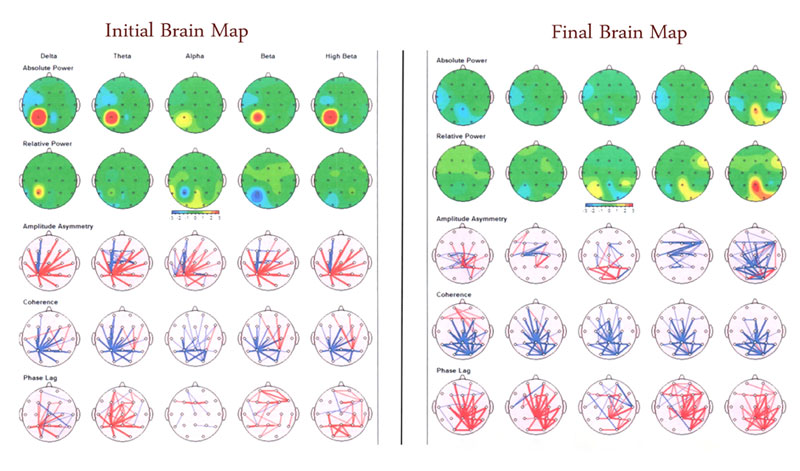Document The Effectiveness of Our Program
Gratefully, we’ve long enjoyed the reputation of an effective program. Not only do our clients and their loved ones tell us that our program works, but we have witnessed profound transformations firsthand in our day-to-day work. The efficacy of the program is further validated by measured client progress in treatment such as the OQ-45.2 survey, the PLC-5 PTSD assessment tool, and the BIT survey. These are nationally recognized clinical assessment instruments designed to measure treatment progress.
In addition, with a very practical application of neuroscience technology, we have documented the effectiveness of our addiction recovery program through an 8-year brain mapping research project. We monitored the electrical activity of brain functioning in more than 500 Sanctuary clients.
Brain Mapping allowed us to observe and measure how brainwaves move throughout the brain and at what frequencies. We also monitored how different parts of the brain communicate with each other. We could see brain regions that are over-active, for example, producing particular symptoms of distress, and we could see regions that have too little activity, causing deficits and other symptoms. In short, we saw clinical issues and symptoms at a neurological level, and over time, we saw neurological change as the result of participation in our program. We are very pleased to say that the results were remarkable. We have found dramatic evidence that our program brings about deep and transformational change in brain functioning. Our program facilitates true addiction recovery, which can be measured.
The Brain Mapping Process (8-year brain mapping research project)
At the beginning of the program, we obtain a Brain Map, or type of EEG from each participant—a Quantitative Electroencephalograph (qEEG), in order to establish a baseline against which future Brain Maps can be compared. We then take another Brain Map at the end of the program and can compare. Quite simply, Brain Mapping makes an individual’s level of well-being or distress visible in an objective, observable, and measurable image of brain activity. Each Brain Map is a snapshot—a depiction of the neurological underpinnings of a person’s mental, emotional, physical, and spiritual state of functioning at any given time.
The initial Brain Maps we obtain from participants show us neurological evidence of the distress they bring with them when they enter our program. We see the neurological workings, for example, of addiction, trauma, depression, and anxiety, as well as the specific symptoms of such conditions like the inability to pay attention and to remember, poor impulse control, dysregulated emotion, impaired problem-solving, poor judgment, and poor decision-making.
All of these things are characteristics of people in distress who are unable to resolve their problems and live the lives they want to live. Also, conversely, we can clearly see evidence in Brain Maps of more healthful functioning when these issues have been resolved. The 8-year brain mapping research project has concluded.




